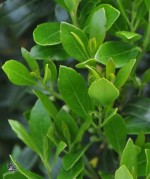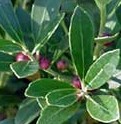 Native from Nova Scotia to Florida and west to Mississippi where it grows in swamps, inkberry is a medium sized broad leaved evergreen shrub. It has a spreading habit and readily suckers to form colonies. Although young plants may be dense and compact older ones tend to get leggy but can be kept dense by pinched or rejuvenated by heavy pruning. The shiny dark green leaves are 1-2″ long, spineless and may develop a purple tinge in winter Small male and female flowers are formed in the spring on separate plants and a male inkberry plant must be in the area for female plants to produce their small shiny black berries in fall. The flowers are an important source of nectar for honey bees and the berries provide food for many birds. Easy to grow in moist sunny to shady conditions, inkberry is a fine shrub for massing and is useful in hedges and foundation planting. Because of its salt tolerance inkberry is especially useful in seaside plantings.
Native from Nova Scotia to Florida and west to Mississippi where it grows in swamps, inkberry is a medium sized broad leaved evergreen shrub. It has a spreading habit and readily suckers to form colonies. Although young plants may be dense and compact older ones tend to get leggy but can be kept dense by pinched or rejuvenated by heavy pruning. The shiny dark green leaves are 1-2″ long, spineless and may develop a purple tinge in winter Small male and female flowers are formed in the spring on separate plants and a male inkberry plant must be in the area for female plants to produce their small shiny black berries in fall. The flowers are an important source of nectar for honey bees and the berries provide food for many birds. Easy to grow in moist sunny to shady conditions, inkberry is a fine shrub for massing and is useful in hedges and foundation planting. Because of its salt tolerance inkberry is especially useful in seaside plantings.
Type:Broad leaf evergreen shrub
 Outstanding Features: Foliage
Outstanding Features: Foliage
Form: Upright oval mound; suckering colonies.
Growth Rate: Slow to moderate
Bloom: Small white male and female flowers are produced on separate plants in spring; black berries on female plants in fall.
Size: 4-6′ H x 2-12′ W
Light: Full sun to part shade
Soil: Average, moist, well-drained, slightly acidic; tolerates flooding
Hardiness: Zones 5-9
Care: Prune in spring before new growth begins to shape; pinch to keep plants dense; prune heavily to renew old leggy plants.
Pests and Diseases: Generally disease and pest tolerant but susceptible to leaf spot, root rot, scale, aphids and leaf minor.
Propagation: Division of suckers from parent plants, semi-hardwood or hardwood cuttings,seed
Outstanding Selection: ‘Shamrock’ ( compact, dense, slow growing, 5″ tall).
